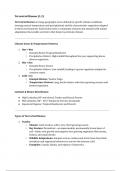Terrestrial Biomes (1.2)
Terrestrial biomes are large geographic areas defined by specific climate conditions
(average annual temperature and precipitation) and the characteristic vegetation adapted
to these environments. Each biome hosts a community of plants and animals with unique
adaptations that enable survival in that biome's particular climate.
Climate Zones & Temperature Patterns
1. Hot + Wet
○ Example Biome: Tropical Rainforest
○ Precipitation Pattern: High rainfall throughout the year, supporting dense,
diverse vegetation.
2. Hot + Dry
○ Example Biome: Desert
○ Precipitation Pattern: Low rainfall, leading to sparse vegetation adapted to
conserve water.
3. Cold + Icy
○ Example Biomes: Tundra, Taiga
○ Temperature Pattern: Long, harsh winters with short growing seasons and
limited vegetation.
Latitude & Biome Distribution
● High Latitudes (60° and above): Tundra and Boreal Forests
● Mid-Latitudes (30° - 60°): Temperate Forests, Grasslands
● Equatorial Regions: Tropical Rainforests and Deserts
Types of Terrestrial Biomes
1. Tundra
○ Climate: Cold, treeless, with a very short growing season.
○ Key Feature: Permafrost—an impermeable, permanently frozen layer of
soil—limits root growth and supports low-growing vegetation like mosses,
lichens, and small shrubs.
○ Wildlife Adaptations: Animals such as caribou and Arctic foxes have thick
insulation and migratory behaviors to survive the extreme cold.
○ Examples: Canada, Alaska, and regions of Antarctica.
, 2. Boreal Forest (Taiga)
○ Climate: Cold winters and mild summers with moderate rainfall.
○ Vegetation: Dominated by coniferous (cone-bearing) evergreen trees like
pine, spruce, and fir, adapted to conserve water and shed snow.
○ Wildlife Adaptations: Animals like moose, wolves, and lynxes have thick fur
and behaviors that allow them to thrive in colder conditions.
○ Location: Found between 50°N and 60°N in Europe, Russia, and North
America.
3. Temperate Rainforest
○ Climate: Mild temperatures with high precipitation year-round, often due to
coastal proximity.
○ Vegetation: Lush, dense forests with evergreen and deciduous trees, ferns,
and mosses. The moist conditions support large tree growth and diverse
understory plants.
○ Examples: East coast of Australia, Southern Chile, Pacific Northwest of North
America.
4. Temperate Seasonal Forest
○ Climate: Warm summers and cold winters, with around 1 meter (39 inches)
of precipitation annually.
○ Vegetation: Broadleaf deciduous trees like oaks, maples, and beeches
dominate, shedding leaves in winter to conserve water.
○ Wildlife Adaptations: Squirrels, deer, and birds are common, adapting to
seasonal changes with behaviors like food caching and migration.
○ Examples: Eastern United States, Europe, Japan, China, Chile.
5. Woodland/Shrubland (Chaparral)
○ Climate: Hot, dry summers and mild, rainy winters.
○ Vegetation: Shrubs and small trees with drought-resistant adaptations, such
as leathery leaves to minimize water loss.
○ Wildfire Adaptations: Many plants are fire-resistant or have seeds that
germinate only after fire.
○ Examples: Mediterranean Basin, Southern California, Southern South
America.
6. Temperate Grassland / Cold Desert
○ Climate: Cold, harsh winters and hot, dry summers.
○ Vegetation: Grasses are dominant, with few trees due to low rainfall; shrubs
appear in drier regions.
○ Wildlife Adaptations: Animals like bison and prairie dogs are adapted for
grazing and burrowing to escape temperature extremes.
○ Examples: Great Plains of North America, Pampas of Argentina, Steppes of
Eurasia.




